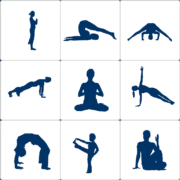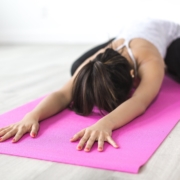Top 10 Must Know Yoga Poses – Beginner to Advanced
The benefits of effective yoga poses cannot be understated. Not only do they burn calories and tone muscles, but they also improve yogis’ mental states through relaxation. But there’s simply a lot of poses out there – some are intense, others are relaxing.
Here’s a compilation of poses that you need to know about today:
Beginner Poses
-
Mountain Pose
How to perform it
Maintain a standing pose with your feet separated slightly. Lift your toes then lay them on the floor. Rock side to side. Slowly reduce the movement until you reach a standstill.
Firm up the muscles in your thigh while lifting your knee caps. Widen your shoulders towards your back, and release them gradually. Hang your arms on your torso. Maintain your head’s crown above your pelvis, while your chin’s underside is parallel to the ground. Ensure you’ve softened your eyes. Breathe slowly as you maintain this pose for about a minute.
Benefits
While it may appear too easy, the mountain pose provides the blueprint for the rest of the Yoga poses. It improves your presence and your balance while strengthening your knees and thighs. To some extent, it may also reduce flat feet.
Practice Tips
You can improve your alignment by checking how you position yourself, with your back facing the wall. Maintain a still position with your shoulder blades and heels touching the walls. But ensure the backside of your head does not make contact with the wall.
Also, challenge yourself by doing the pose while your eyes are closed. Your balance will improve as you continue this practice. You can also get a partner to check whether you’re doing the pose well enough. Instruct them to check whether your outer hip’s center, exterior ankle bone, and ear hole align perpendicularly towards the floor.
-
Downward Facing Dog
How to perform it
The pose helps stretch your legs, back muscles, and chest. Get on the floor and ensure your hands and knees touch the mat. Your knees should be directly under your hips while your hands are slightly further forward to your shoulders. Ensure your toes are turned under, and your palms are spread.
Breathe out and raise your knees above the floor. Firstly, get your knees bent a bit, and pop your heels up from the ground. Despite the resistance, raise your sitting bones high and move your inner legs up towards the groin.
Exhale while pushing thighs back. Ensure your knees are straight, but don’t lock them. Firm the shoulder backs then draw them down in the direction of your tailbone. Don’t let your head hang – maintain it between your top arms. Stay in that position for about 1-3 minutes.
Benefits
- Helps to calm the brain
- Energizes your body
- Improves your arm and leg strength
- Helps reduce menstrual discomfort
- Can improve digestion
- Reduces back pain and headaches
Practice Tips
You can modify how far your legs’ backs stretch. To deepen the pose, raise yourself a bit while pulling your heels away from the ground by half an inch. You can then move your inner groins towards the pelvis. Finally, drawing your outer heels quickly, straighten your heels back to the ground.
If you find it challenging to open and release your shoulders, use the back of a chair to lift your hands from the floor.
You can also challenge yourself further. Create a position where you’ve raised your right leg and straightened it to the direction of your torso’s line. Balance your hips and press through your heel. Exhale while releasing, and repeat the pose with the left leg this time.
-
Tree Pose
How to perform it
Remember the mountain pose? Begin in that pose. Now locate a stationary point and stare at it to improve balance.
While inhaling, shift your weight to your left foot then raise your right foot slightly. Use your right hand to bring the foot closer to your inner thigh, but don’t place your foot directly on top of your knee.
Stand tall by lengthening your tail bone to the direction of the floor. Maintain a prayer-hands pose by bringing your palms together in front of you. Hold the position while taking about 8-10 breaths. Ensure your shoulders are relaxed, and your abdominals are engaged.
Practice Tips
Experiment with your balance by raising your hands to the ceiling to form a V-shape. Gaze towards the sky. If you feel you’re experienced enough, you can close your eyes.
To avoid misaligning the supporting hips and knee, don’t turn the standing leg outwards. Also, avoid positioning your foot on the other knee. Always ensure the leg is either below or above your knee to protect the opposite knee from getting injured.
Benefits
- Improves concentration
- Strengthens your outer hips and feet.
- Improves balance
- It helps you feel grounded.
Intermediate Poses
-
Revolved Triangle
The Revolved Triangle can be a difficult pose for even the yoga pros — it combines hamstring stretching, thorough twisting, with imperious balance.
How to perform it
Start with your legs kept 3 feet apart. Turn your right foot by 45 degrees, make a step forward with your left foot, and keep your hips squared.
Inhale and take your torso in front of your leg, while your hands are held on your hips. Ensure your spine is completely straight. Place your right hand below your left shoulder and your left hand on the base of your spine. Twist your torso and open your chest towards the left.
Take a deep breath and raise your left hand. Place the left shoulder above the right and breathe out. Maintain a gaze on your right fingertips. Take a couple of breaths and remain in the position for about a minute.
Practice Tips
When you find it difficult to align properly, it’s advisable to set up a few props. A block under you can improve your stability. You can also provide more room for your torso to move by positioning your right hand in front of your left foot.
While the pose can be challenging enough for most practitioners, you can make it even more difficult by making some modifications. You can place your hand outside the forward leg while your forearm is pressed directly to your skin.
It’s recommended that you don’t practice the pose if:
- You’re pregnant
- You’re experiencing any form of neck or lower back pain
- You’ve had surgery recently on your neck or back
- You have hypotension
Benefits
- Improves flexibility and mobility
- Enhances core strength
- Can improve your focus
- Opens your chest and shoulders
- Eases pain
-
Feathered Peacock Pose
How to perform it
Kneel on your mat. Ensure you’re at least 4-inches away from your wall. Place your palms on the mat. Keep your fingers spread while pointing them in a straight direction. Your elbows should be directly underneath your shoulders.
Raise your knees above the ground while stretching your legs behind you. Lift your hips as high as possible. Thrust your shoulders above the floor while pulling the shoulder blades towards your back. Raise your head and look at the wall you’re facing.
Push yourself up using one leg as a spring. Ensure it is placed towards your body’s midline. The other leg should remain straight. Engage your thigh muscles to keep your legs straight. Continue lengthening your back as you raise your legs. Also, draw your navel towards your spine.
Avoid the pose if you have any of the following conditions:
- Shoulder pains
- Headache
- Heart condition
- High blood pressure
- Menstruation
Practice Tips
With the help of a block, you can make the pose easier to achieve. Press your palms on the block and ensure your wrists are at 90 degrees to your floor. Curve your fingers around the block’s back, and then let your fingers touch the wall.
To make the pose more challenging, you need to position yourself away from the wall.
Benefits
- Enhances your back’s and arm’s strength
- Allows your shoulders and chest to stretch
- Improves your balance
- Relives depression and stress
-
Dolphin Plank Pose
How to perform it
Bend in your knees and get into the Dolphin Pose. Slowly take a few steps back with your feet to ensure your elbows are directly below your shoulders. Also, make your torso parallel to the ground.
Ensure your forearms and elbows touch the floor firmly. Spread your shoulder blades away from your spine, as you draw them against your back.
Lift your front thighs in the direction of the sky, but draw your tailbone in the opposite direction into the floor while stretching it towards your heels. Maintain the pose for approximately 30 to 60 seconds. Finally, exhale as you free your knees towards the floor.
Practice tips
You can position a block in between the forearms, and rest your forehead there to release any neck tension.
Benefits
- Can prevent osteoporosis
- Enhances the strength in your arms and legs
- Relieves any form of stress and depression
- Helps stretch your shoulders and hamstrings
-
Side Plank Pose
How to Perform it
Start the process in the plank pose. Move your weight to the right hand and raise the left hand towards the sky. Position your left foot above your right foot, while you open your chest in the left direction. Ensure your legs are straight and then buckle the feet firmly.
The left hips should be above the right one. Lift both hips upwards to resist the pull to the floor. Gaze directly to the left fingertips. Take a few breaths, then take your hand and foot back to the floor and return to a plank. Repeat the procedure using the other side.
Practice tips
It’s easier to perform the pose when your soles are up on the wall. When doing the easy version of the pose, ensure your foot is halfway to your hand. Use the right foot as support.
Benefits
- Improves your balance
- Can boost the strength in your arms and belly.
- Stretches your wrist
Advanced Yoga Poses
-
Noose Pose
How to perform it
Begin the process with Tadasana, and make sure your feet are close together. Gradually bend your knees to achieve a squat. Move your buttocks towards the heels. Shift your knees a bit to the right.
Breathe out, then take your torso to the left. Allow your upper body to touch your left thigh. Raise your right arm upwards then rest it on your left shin’s outer side. Move your right arm to face the ground.
Ensure you have wrapped your arm on the shins. Shift your left arm around your back. Using your right arm for support, rotate your upper body to the left direction. Rotate your head to the left then move your shoulder blades closer to the spine. Maintain the pose for some seconds, preferably 20-50 seconds. Breathe out as you get out of the pose, then repeat using the opposite side.
Benefits
- Can improve digestion
- Can lead to increased oxygen intake
- Boosts the strength of the hips and ankles
- Releases any tension in your back or shoulder
- Controls blood circulation
- Reduces discomfort during menstruation
- Can cure asthma and flatulence
- Stimulates your abdominal organs
Practice Tips
You can also practice the Noose Pose while sited on a chair.
Use the arm wrapped around your legs to boost the twist, by pulling down on your top arm.
-
Peacock Pose
How to Perform it
When you’ve bent on all fours, rotate your hands to get the fingertips to face in your direction. Join both of your hands right below your belly button. Incline your elbows, then ensure your pinky fingers touch to make a connection to your elbows.
Engage your core. Gaze forward as you shift your weight towards the direction you’re facing. Continue pressing your arms in each other’s path. Raise your upper back. Return your legs each at a time until you get a Plank-like position. Press your thighs together.
Experiment with your balance by floating each leg until you can comfortably lift both legs.
Practice Tips
It is easy to assume that the arms are the most essential feature in this pose. However, it’s the core strength that does the majority of the work. When your core is strong enough, you can easily experiment with your balance. You can always shift your weight forward to allow your legs to float effortlessly.
Benefits
- Enhances your forearm strength
- Tones the abdomen
- Strengthens the legs
-
Firefly Pose
How to Perform it
Get into a wide squat. Ensure your palms lie directly on the floor below your feet. Give you elbows a slight bend back. Start shifting your weight to your upper arms as you lift your feet from the floor. Straighten your legs. Finally, straighten your arms.
Practice tips
The Firefly Rose, just like other arm balances, looks complicated, but it’s actually easy to perform. When you fall, you’ll most likely land on your bum, so you’ll be avoiding head injuries. If you’re unable to straighten your legs after you raise your feet, then attempt to cross your feet at your ankles.
Always stretch your hips and hamstrings as you try to do the pose. And for maximum balance, keep your eyes gazed forward, and your core tight.
Benefits
- Strengthens arms
- Tones abdominal region
- Improves balance
- Boosts flexibility in the groin area
Final Thoughts
There are a lot of yoga poses out there, but the ones above are relatively easy to practice, don’t require much effort, and provide various benefits. Next time you’re going for a Yoga session, try any of the mentioned poses, and maybe you’ll notice the results. Considering being a yoga teacher trainer? Why not check out out yoga teacher training (YTT) course available in the amazing country that is Costa Rica.









